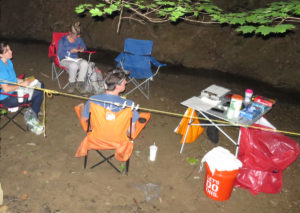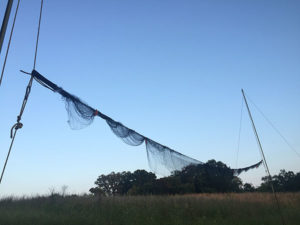
Mist netting to capture bats is commonly conducted along wooded corridors, such as this one over a small stream in eastern Illinois
The Illinois Bat Conservation Program uses mist netting as a survey method to gain valuable information about Illinois bat populations. Mist netting locations are selected in cooperation with Illinois Department of Natural Resources (IDNR) biologists and resource managers, with the intention of focusing efforts on areas where few a bat inventories have been conducted, as well as where there is a particular interest in determining bat presence and species composition.

During mist netting, we must be prepared to weigh bats and collect other data, including feces for environmental DNA work. In addition, mist nets are checked every 10 minutes for bats. We set up a small workstation away from the nets, where we wait patiently for bats, and take turns checking the nets.
Mist nets are rectangular nets comprised of fine threads that are inconspicuous, especially in the dark. We try to set up the nets near features such as stream corridors and trails that tend to funnel bats towards the net. It is particularly useful to set up the nets suspended over water, as bats drink and feed on flying insects over the water, especially in the early evening. Feeding and eating activities may also distract the bats, making them less aware of the nets.

A mist net setup, just before sunset – once sunset arrives, we’ll unwrap the nets and raise them up on the two poles, like sails on a mast. The nets are difficult for bats to detect with their ultrasonic calls, and if we’re lucky, we’ll catch a bat! Location is important, and although the photographic angle doesn’t show it, this net is set up next to a pond which is mostly surrounded by woods. We positioned the net next to the tree line, spanning out across where the pond joins the open prairie, hoping to catch a bat using that route to access the water.
Once the nets are deployed, the mist netting team sits quietly away from the netting area, and checks for captured bats in the nets every ten minutes for approximately five hours. Everyone who handles bats has received a rabies vaccination and wears leather gloves for added protection. When a bat becomes entangled in the net, we gently remove it and take a series of measurements and notes on important characteristics such as sex, reproductive status, and age.
These parameters, as well as our identification of the species of the bat, build information on the population structure in the area, which may be especially informative when making management decisions. For example, in the summer months, some species of bats form maternity colonies in which the females congregate together during pregnancy and for several weeks after birth, separate from the males. If we catch multiple females in one location, this suggests that there is a maternity colony nearby, or that the area may function as an important foraging location for reproductively active females.
Land managers concerned about bat conservation can use this information in various ways, such as protecting select trees or forest tracts where maternity roosts are located. After collecting data from the captured bat, we release it a short distance from the net. Previously captured bats may be much more cautious of the nets, as suggested by low recapture rates of individual bats.
Using the information gained through mist netting and our acoustic data gives a much more comprehensive view of the local bat population than we would acquire by either method alone. Due to the bias of all survey methodologies, we are employing a variety of methods (stationary acoustics, mobile transects, roost counts, mist netting, radio tracking, and environmental DNA) in order to produce more comprehensive picture of Illinois bat populations and a deeper understanding of how bats utilize available resources in the state.
